Mary root care
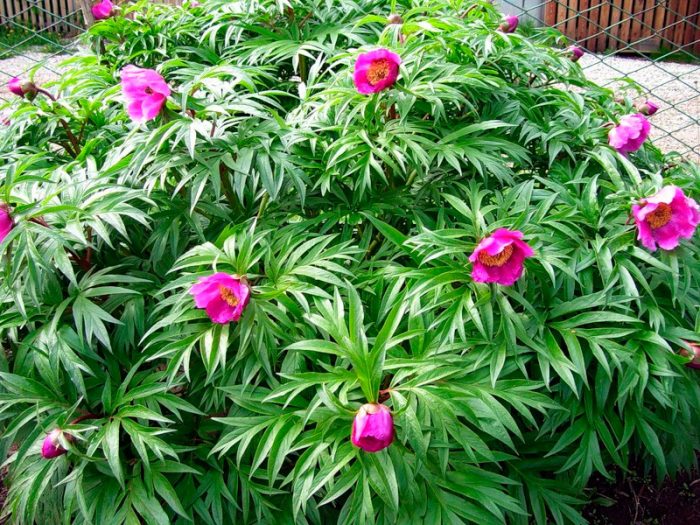
Maryin root is distinguished by its undemandingness, and it is also unpretentious in care. Therefore, it is quite simple to grow it on your site.
Watering
This plant does not need frequent watering. At a time, from 20 to 30 liters of water is poured under 1 bush. In order to prevent the spread of water over the site during irrigation, it is recommended to dig in pipe sections around the bush. If water is poured directly into them, then it will be absorbed into the soil layer in which the root system of the maria root is located. In early spring, during the period of bud formation, and even during the laying of flower buds in August, the bush especially needs a sufficient amount of moisture. When it rains or the plants are watered, you need to loosen the surface of the soil near the bushes. You should also pull up all the weeds.
Fertilizer

While the plant is young, it is recommended to feed it foliarly. Such dressings begin to be carried out regularly in May. To do this, once every 30 days, the bushes need to be watered from a watering can, using a solution of Ideal or another mineral fertilizer. In this case, in 1 bucket of nutrient solution, before watering, you need to put 1 large spoonful of washing powder or liquid soap. It is recommended to feed the evading peony in this way in the evening or on a cloudy day.
During intensive growth, adult plants need to be fed by foliar method 3 times with an interval of 20 days. And it is necessary to start such top dressing from the second half of May. During the first feeding, a urea solution is used (50 grams of substance per bucket of water). For the second feeding, one micronutrient tablet is dissolved in 1 bucket of a nutrient mixture containing urea. For the third feeding, a nutrient solution is taken, consisting of 1 bucket of water and two micronutrient tablets.
It is recommended to feed adult bushes by the root method, however, it should be borne in mind that in each period of development they need certain substances. At the beginning of the growing season, the Maryin root needs nitrogen, during the formation of buds and flowering, it needs phosphorus, nitrogen and calcium, and during the laying of flower buds for the next year - phosphorus and potassium. In this regard, during one season, the bush should be fed 3 times by foliar method:
- In the last days of March or the first days of April, 10 to 15 grams of potassium-nitrogen fertilizer should be applied to the soil under one large plant. If at this time there is still snow on the site, then the granules must be evenly distributed over its surface. When the snow begins to melt, the nutrients needed by the plant will penetrate the soil along with the melt water.
- In the last days of May or the first days of June, the bushes are fed using a phosphorus-nitrogen-potassium solution (20:10:10). Instead of such a solution, you can take organic matter. So, bushes can be spilled with a solution of mullein (1:10) or bird droppings (1:25).
- After the plant has faded, after half a month, 15 grams of potassium fertilizer and the same amount of superphosphate should be added to the soil under the bush. Around the plant, you need to make a groove in which the required amount of fertilizer is evenly distributed. Then it is spilled with a lot of water and covered with soil.
Wintering
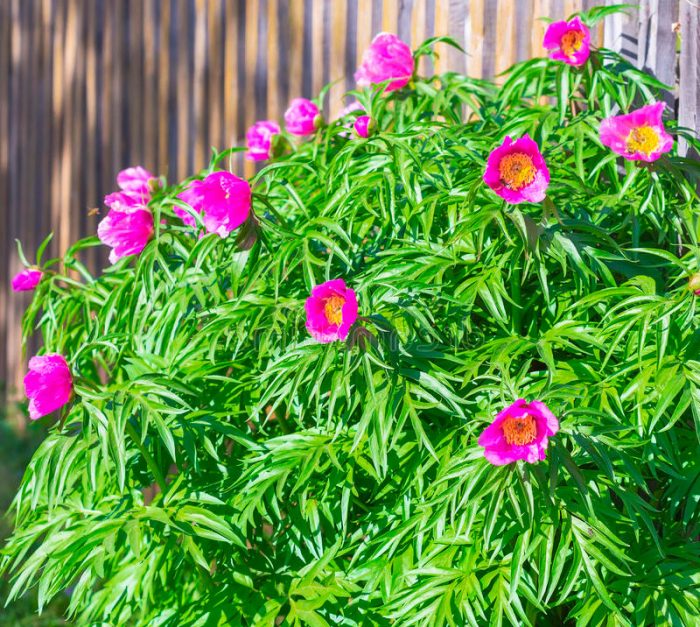
During the preparation of the plant for winter, its shoots must be cut almost to the very surface of the soil. Then the bush must be covered with wood ash from above, two or three handfuls should be enough. It is necessary to shelter for the winter only young specimens that are under 3 years old.And adult bushes do not need shelter, as they have a fairly high frost resistance.
Diseases and pests
Such a plant is highly resistant to diseases and pests. However, it can, under certain circumstances, get sick with gray rot. In order to prevent this and another fungal disease, the bushes need to be treated with a solution of Bordeaux liquid 3 times (50 grams of the substance is taken for 1 bucket of water). Marin root is sprayed in the spring after the appearance of young shoots, then it is treated a couple more times with an interval of 10-12 days. When spraying one bush, it should leave from 2 to 3 liters of solution.
Such a culture is also susceptible to rust infection. For prevention purposes, the plant is treated with a solution of copper oxychloride (60 grams of the substance and a small amount of liquid soap are taken for 1 bucket of water). You can replace it with a solution of Bordeaux mixture (see above) or colloidal sulfur (100 grams of substance for 1 bucket of water).
Maryin root, Part 1, Cutting
Evasive peony (Maryin root): description and characteristics
Evasive peony (Paeonia Anomala, aka Maryin root or Maryina grass) is a herbaceous perennial plant that is part of the Peony family. In nature, the flower grows in the Altai Territory, on the mountain slopes of East Asia. In Russia, its habitat is Siberia and the Komi Republic.

Red wild peony dodging is found in various regions of the Russian Federation
Its stems are convex-ribbed, pink-purple at the ground, stretching up to 1.5 meters in height, covered with patterned dark green leaves along their entire length. Flowers from 8 to 13 cm in diameter are painted in a deep pink color, the middle is bright yellow. The root system is tuberous, reddish-brown on the outside and white on the cut. The roots of the plant taste sweet and have a characteristic odor. The plant has an approximate lifespan of 25–30 years.
Maryina grass is a useful flower, contains many biologically active substances and has a number of medicinal properties. Parts of the plant are used as a folk remedy for mental overload. Medicine is considering a plant to create various drugs:
- relieving spasms and cramps;
- pain relievers;
- alleviating the condition with nervous excitability;
- normalizing the work of the circulatory system;
- used in the fight against viral diseases.
Tinctures, which include the root of the evading peony, help in the treatment of gastritis, getting rid of colic and diarrhea. Also, the peony Maryin root stimulates metabolic processes, increases the acidity of the stomach, and serves as a prophylactic agent for the appearance of malignant tumors.
The evading peony has found its application not only in folk medicine. The plant is a good honey plant. It is used in the preparation of the drink "Baikal". In Siberia, the dried roots of Maryina's grass are classified as homemade spices and are added to meat dishes to add aroma and taste. In Kazakhstan, the seasoning is put into porridge, and in Mongolia it is brewed as tea.
Gardeners appreciate the plant for its decorative qualities. It is often planted as part of landscape compositions for the improvement of summer cottages and personal plots.

The evading peony takes root well in the garden
Maryin root: water and alcohol tincture
Preparation of an aqueous tincture: the tuberous roots of the evading peony are dried in the sun. Then it is crushed to powder. Insist in the proportion of 2 cups boiling water and 1 teaspoon of peony, leaving overnight under the lid. After straining, the water infusion is kept in the refrigerator and drunk in 1/4 cup 15 minutes before meals - based on 3 main meals. Such an infusion does not give side effects, if the dosage is not exceeded.
Preparation and reception of alcohol tincture: 150 grams of dry roots are placed in a glass bottle and 200 ml of alcohol is poured.Plugged with a cork and kept for 7-10 days in a dark place. The tincture is taken in an amount of 20-40 drops immediately before meals. The course is 1 month, then a break of at least 10 days is required, and the treatment can be continued.
Peculiarities
The duck peony is cultivated as a perennial and can grow in one area for more than 10 years, like any other plant in this family.
Let's take a look at a brief botanical description of this peony.
- Adult plantings can often grow up to 1.5 meters in height.
- The stems have a branched structure, mostly single flowers.
- The buds of peonies of this variety are very large, in diameter they can reach 13 centimeters. The shape of the flower bowl is correct. On each of them there are at least five petals, they are painted in crimson-pink color. The inflorescence has a large number of yellow stamens.
- The triple-separated plates of petiole leaves of a peony are colored green. They have a lanceolate shape, reach 30 centimeters in length, the same indicator in width. With the onset of autumn, the leaves take on a dark red hue.
- The evading peony has a powerful root system, it is characterized by spindle branching of the roots, which are painted in a dark brown color. In the course of its development, a perennial rhizome can go deep into the ground up to 90 centimeters. Differs in a high content of nutrients. Every year, new roots are formed around the old roots, which begin to develop intensively during the growing season.
- No more than five leaflets are formed from the pistils of a peony. The fruits contain small black seeds. They usually ripen in late summer or early fall.
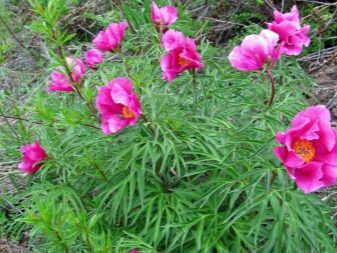
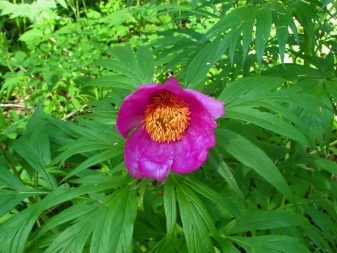
Nursing and illness
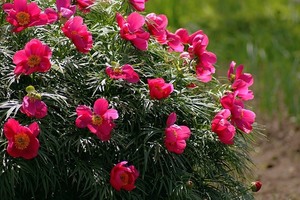 Maryin root is an unpretentious plant. It does not require special care, but the timely planting of a perennial bush of a peony dodging has a beneficial effect on growth. The flower takes root well under the crown of fruit trees or small shrubs.
Maryin root is an unpretentious plant. It does not require special care, but the timely planting of a perennial bush of a peony dodging has a beneficial effect on growth. The flower takes root well under the crown of fruit trees or small shrubs.
The soil should be moderately fertilized, since the plant is long-lasting and requires a lot of nutrients and useful microelements. Flowering begins earlier than other types of peonies; when the bush withers, the foliage will retain a bright shade until late autumn. It needs watering, but not often, because it tends to accumulate moisture. Loves loose soil and lack of draft.
Weeds need to be removed as they emerge, as they carry harmful bacteria and suck out all micronutrients from the soil. Faded, diseased and dry shoots are removed in time with secateurs. During the growing season, constant loosening of the soil is necessary. The tall stems of the dodging peony require supporting props.
Florists need to take into account that Maryin's root is susceptible to the following diseases:
- Gray rot is a common ailment of this peony variety. For prophylaxis in the spring, when shoots appeared, the bush is treated with Bordeaux mixture at the rate of 50 grams per 10 liters of water. The solution is poured over the peony roots every 2 weeks 3 times.
- Rust is a brownish-yellow blistery sore on the leaves of a plant. If the flower is not processed, it dries quickly and dies. Before the procedure, remove all wilted shoots, buds, flowers. Then Maryin root is sprayed with Bordeaux mixture at the rate of 150 gr. for 15 liters of water. The dosage can be reduced depending on the size of the bush.
How to drink a peony evading (Maryin root)
Depending on the specific disease, the rules for preparing the tincture may vary. In addition, you need to know the clear dosages of folk remedies for various ailments.
From pressure
The tannins in the eluding peony tincture improve the elasticity of blood vessels. With hypertension, the remedy has a complex effect, relieves spasm and accelerates blood flow. The medicine is prepared as follows:
- 50 g of dry peony root is poured with 500 ml of vodka;
- shake the product and leave for 3 weeks in a dark place;
- filtered before use.
You need to drink Maryin root three times a day, 30 drops on an empty stomach. The treatment is continued for a month, then a break is made for 10 days and, if necessary, the course is repeated.
For insomnia and nerves
The benefits of dodging peony tincture are in demand for neuroses and sleep disorders. Prepare a remedy in a similar way:
- 50 g of raw materials are poured with half a liter of vodka;
- insist the remedy for 2 weeks in the dark, shaking from time to time;
- at the end of the term, filter.
It is necessary to use the medicine before bedtime, 3 small tablespoons of tincture are diluted in 50 ml of water. The product quickly relieves stress and helps to relax.
With mastopathy
The medicinal properties of Mary's root in gynecology, and in particular, with mastopathy, are best known. With a female disease, a multi-component tincture is made from several ingredients:
- mix the roots of peony and licorice - 1 part each;
- add a tea penny in the amount of 2 parts;
- pour 100 g of the mixture with a liter of vodka.
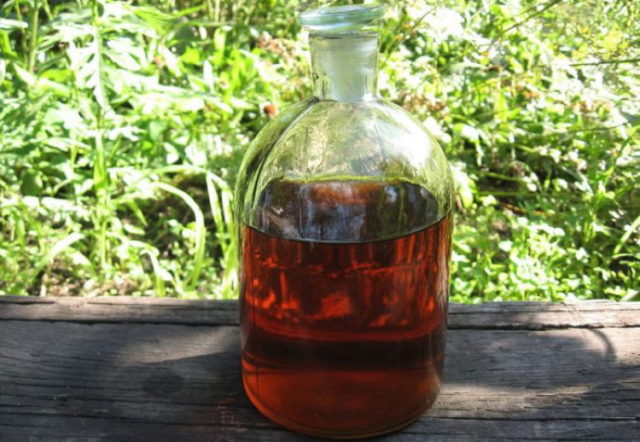 The dosages of the medicinal tincture of Mary's root are very small, no more than 40 drops per dose
The dosages of the medicinal tincture of Mary's root are very small, no more than 40 drops per dose
You need to insist the remedy for 2 weeks in the dark and cool. The finished medicinal drink is filtered, and then taken three times a day in a small spoon.
You need to continue the course of therapy for 2 months, while it is very important to start drinking the tincture on the 4th day of the cycle. With proper administration, the remedy will help get rid of pain and swelling with mastopathy
With menopause
The use of tincture of Mary's root on vodka is allowed during menopause. The medicinal benefit is that the drink has a sedative effect, tones up and normalizes hormonal levels. Prepare the tool like this:
- 3 large spoons of dried peony flowers pour 500 ml of vodka;
- insist the medicinal liquid for 21 days;
- the finished remedy is filtered.
Drinking a strong tincture is recommended three times a day, 25 drops on an empty stomach. The course of therapy lasts a month, during this time the mood is leveled and the hot flashes characteristic of menopause go away.
For relief of joint pain
The ducking peony has analgesic and anti-inflammatory properties. Instructions for the use of tincture of Mary's root recommends using the remedy for joint ailments - radiculitis, arthritis, rheumatism, with inflammation of the sciatic nerve.
 You can use the medicinal peony tincture for rubbing the joints.
You can use the medicinal peony tincture for rubbing the joints.
A classic remedy on dried flowers is used for therapy - 50 g of raw materials are poured with 500 ml of an alcohol base and insisted for 2 weeks. But they use the healing liquid externally - they rub the sore joints several times a day. The beneficial substances in the composition penetrate the tissues through the skin and quickly relieve pain.
For epilepsy
A valuable area of application for the dodging peony is in the treatment of epilepsy. Tincture based on the roots and flowers of the plant has strong anticonvulsant properties, but has fewer side effects. Apply it like this:
- for 2 weeks, 50 g of dry raw materials are kept in 500 ml of vodka;
- after the expiration of the period, the medicinal product is filtered;
- consume 1 small spoon three times a day on an empty stomach.
Attention! Therapy of epilepsy with the evading peony should only be carried out with the permission of a doctor and in combination with official medications.
Growing on the site
The planting site should be sufficiently well lit and well drained. At a high level of groundwater, they make high ridges or arrange drainage ditches, since the peony does not tolerate damp and wetlands and the close standing of groundwater. And with excessive shading, it simply does not bloom. It grows well both on humus and clay soil.
Reproduction
The Maryin root is propagated by seeds, dividing bushes, layering, pieces of rhizomes with roots, stem cuttings.Since the seeds of the dodging peony germinate very poorly, the most convenient and fastest way is vegetative propagation.
The most common vegetative propagation method is by dividing rhizomes with roots. At the same time, more than 50% of plants bloom next year. In the middle lane, the peony is propagated in August-September. For this, not very old bushes are selected. Like decorative varieties, the cuttings are planted in specially prepared planting pits at a distance of 60-70 cm from each other. The planting pits are filled with an organic-mineral mixture at the rate of: 15 kg of organic fertilizers, 200 g of double superphosphate, 150 g of potassium sulfate and 80-100 g of lime. The upper part of the pit is covered with soil. Then the plants are watered and necessarily mulched with peat. In this case, the buds should be covered with mulch.
The first feeding with complex fertilizers is carried out in the spring, when young shoots appear, fertilizers are slightly embedded in the soil, loosened and mulched. During the dry season, it is necessary to water the plants once a week at the rate of 10 liters per bush. In the fall, watering is stopped. Peonies respond well to feeding with microelements - manganese and boron. To do this, boric acid and potassium permanganate are added to a bucket of water at the tip of a knife, which is dissolved until the water turns light pink.
2 weeks before flowering, the plants are fed with mullein infusion mixed with small amounts of potash and phosphorus fertilizers. In autumn, it is necessary to cut off the aboveground part, leaving shoots about 10 cm long in the root zone.Under each bush, humus is added mixed with wood ash, the plants are mulched with peat or sawdust with a layer of 3-5 cm.
Growing a peony from seeds requires a lot of patience due to the long emergence of seedlings due to the underdevelopment of the embryo and the slow development of seeds due to the low activity of enzymes. When sowing seeds in spring, shoots appear only the next year. If fresh seeds are sown immediately after harvest (in August), then half of the seeds will germinate in the spring of next year, and the rest in another year, while the best germination is observed in unhardened seeds collected at the beginning of ripening, before the leaflets open. You can store the seeds at room temperature for a year, and then sow before winter. Then their germination will also be relatively high.
Advice. One of the advantages of a wild peony is its early flowering, which attracts decorators. Maryin's root can be placed in a mixborder and in the form of single plantings against the background of a lawn. Peony foliage is decorative until autumn.
Plant care
When growing peonies, it is necessary to take proper care of them, as this is the main guarantee of success in their development. Maryin root is considered an unpretentious plant, so it can be easily grown at home.
The plant loves warm and well-lit places, which must be taken into account immediately before planting.
Light shade is only welcome, as in the summer season, the scorching sun can damage the bushes. Absolute shade is not the most favorable place for growing peonies. In such conditions, the plant simply may not bloom. And also when planting, you need to keep a distance in relation to other plantings. This is necessary to create conditions for normal air circulation.
Watering
The evading peony does not need frequent watering due to root decay and plant death due to high soil moisture. During watering, one bush requires at least two buckets of water.
It is better not to fill the place around the bush, therefore, drainage bends from the plant should be made in the form of a small rut. Special care for watering is required during the growing season of the plant. When flower buds are set (late summer), the land around the plantation should not be dry.
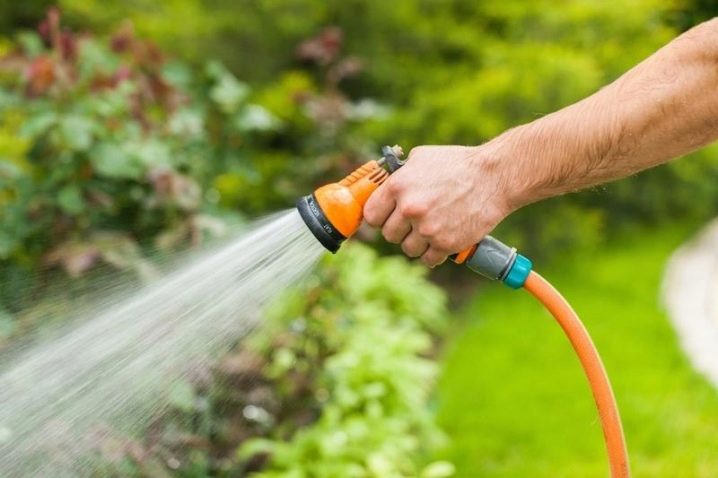
Top dressing
Young plantings are most often fed, relying on the foliar method.From the end of spring, the leaves begin to moisturize well no more than 1 time per month. Various minerals are added to the water for irrigation. It is best to fertilize the plant this way in the evening.
It is recommended to fertilize adult peony bushes during the period of intensive growth. At the end of the spring season, you need to start the process of triple feeding. Between each of them, it is necessary to withstand a 3 week break.
For the first feeding, you will need 10 liters of water with the addition of mineral fertilizer (no more than 50 grams). Usually, flower growers use urea. The second time, a similar solution is used, but it is recommended to add one micronutrient tablet. For the third feeding, you will need 2 micronutrient fertilizer tablets per 10 liters of water.
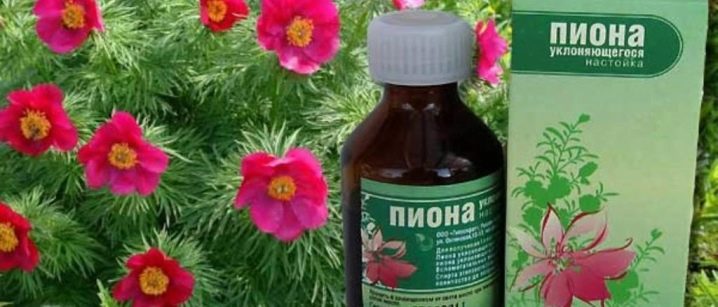
Do not also forget about feeding the rhizomes of peonies. The fertilizer components are selected in accordance with the growth phase of the marian root.
During the season, it is necessary to feed at least three times.
- The first feeding is usually carried out at the end of March, it is desirable that there is still snow on the street. On its surface, it is necessary to lay out a mixture that contains elements such as nitrogen and potassium (15 grams per bush). In the process of snow melting, nutrients with moisture enter the soil.
- The second feeding is done at the beginning of summer. A mixture for fertilizing peonies should be saturated with components such as potassium, phosphorus and nitrogen. You can resort to using organic fertilizer. Bird droppings are perfect for this purpose. You can also use mullein. The fertilizer is best distributed over the hollow around the planting and filled with water. After that, the hollow should be covered with earth.
- The last feeding is carried out two weeks after the cessation of flowering of peonies. Fertilizer must necessarily contain phosphorus and potassium. This feeding process is carried out according to the same method as the previous one.
Pruning
Pruning of the plant is carried out in the fall, a few weeks before the onset of the winter cold. The stems of the plant are completely cut off, after which they should be burned.
Growing Mary's Root
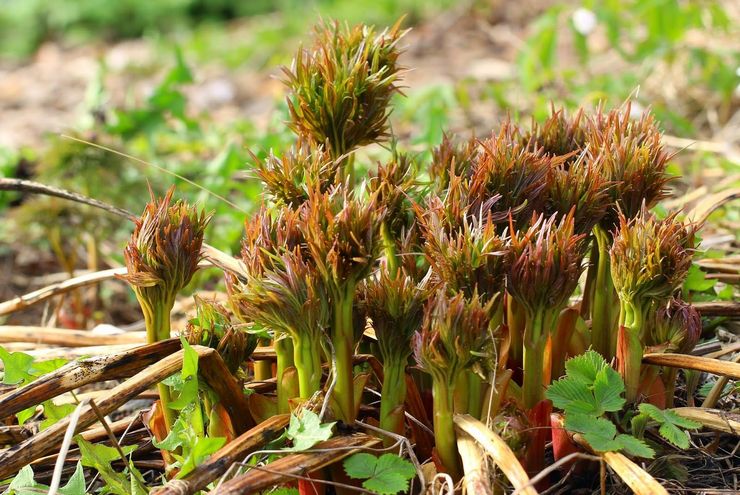
Now in more detail about how the mariin root plant is grown.
Planting Mary's root
Maryin's root is propagated in two ways: vegetatively and using seeds. If there is an adult plant on the site, reproduction is carried out by dividing the root system. Divide in such a way that each of the parts has roots and buds.
Slices must be processed, sprinkled with powdered coal, allowed to dry in the open air. After - placed in pre-prepared wells measuring 50x50x50. Two-thirds of the pit is filled with a mixture of humus, sand, earth, 20 grams of potassium salt and superphosphate are added. The remaining third is filled with nutrient soil. The surface is tamped and moistened abundantly with water. A distance of 70 cm is maintained between the planted plants. The procedure for dividing the root system and transplanting the marian root is carried out in the fall. Cloudy days or evenings when the sun is no longer so bright are favorable.
Maryin root, Part 1, Cutting

The second way is seed propagation. When using seeds collected independently, seed stratification is carried out, which includes 2 stages:
- Stage 1: for a couple of months, the seeds are kept in wet sand, maintaining the temperature at 20 degrees;
- Stage 2: after being in the sand, the seeds are placed in the refrigerator, for example, in a special compartment for vegetables and stored for 6 months.
Seeds stored at room temperature all year round are planted before winter. After - in the spring - they take care of the seedlings of the marin root for 2 years, and only after that they are planted in a permanent place of growth, observing a distance of 70-100 cm between the plants.
Well-lit areas or partial shade are great for growing marin root.The soil should be well permeable to moisture so that the water does not stagnate, and also enriched with useful substances. Organic is welcome. Depleted soils are dug up, adding either humus or compost. If the soil is acidic, slaked lime is added to neutralize the increased acidity.
In the first and second years after planting the marin root, you should not wait for the flowering of the plant. It takes time for him to gain strength before flowering. It is worth waiting and after a while - the plant will delight you with abundant, beautiful flowering
Another important condition for the flowering of Mary's root is proper care.
Chemical composition
The plant is not fully understood, but the main components are known. The composition of Mary's root includes the following substances:
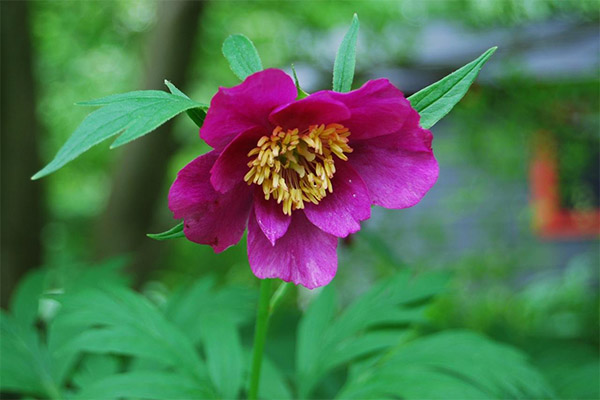
- Fatty oil. This component is necessary for hematopoiesis, strengthening the body's defenses, restoring normal hormonal levels and the biochemical composition of the blood. Also, the substance helps to eliminate harmful cholesterol.
- Essential oil. It gives the plant a characteristic aroma, has a positive effect on the intestines and stomach, enhancing their motility. The substance does not allow the development of fermentation processes, prevents rotting in the digestive system. The oil has a sedative effect on the body, promotes the development of an antibacterial effect, and when using funds from the evading peony, the secretion of the glands is stimulated.
- Flavonoids. They neutralize the negative influence of microbes, contribute to the increased formation of bile. They have an antioxidant effect, prevent the formation and growth of tumors. Strengthen blood vessels, cleanse the body of toxic substances, protect against allergens.
- Tannins (tannin is the main component of the plant). These substances neutralize the harm of pathogenic microbes, have an astringent effect and help the body fight inflammation. The damaged epithelium is restored by the formation of an albuminous film. Tannins reduce the secretion of hydrochloric acid when it is excessively released, and also envelop the mucous membrane that lines the stomach from the inside.
- Organic acids. These substances accelerate metabolism, strengthen bone tissue and joints, and restore the normal acidity level of the environment. Acids have an anti-inflammatory effect, and antioxidant activity is also manifested.
- Minerals. Maintaining a normal level of minerals in the body is required for the full functioning of the endocrine system and the brain, maintaining a healthy state of muscle tissue. When using funds based on peony root, the body is saturated with iron, chromium, cobalt, aluminum, sulfur, copper, potassium.
- Alkaloids. These substances have sedative properties, have a muscle relaxant and analgesic effect on the body, and help reduce blood pressure values. Alkaloids are able to restore any bleeding - both external and internal.
- Glycosidic compounds (the main part of the plant is salicin). Substances contribute to the excretion of phlegm from the bronchi. Under their action, the volume of urine increases, smooth muscles relax. In addition, there is an expansion of blood vessels, a sedative effect develops.
Vegetative propagation
Transplanting plants with shoots is considered convenient and correct. If you do not break the old bush, then in the future flowering may come to naught. The root of the peony evading grows every year and requires a lot of nutrients, so there is no longer enough strength for flowers. How to properly dig up and plant a peony evading Maryin root?
- The most favorable time is late autumn. The soil during this period is moist and easy to cultivate.
- The bush, which requires division, digs in from all sides to the depth of a bayonet shovel. From the peony, you need to retreat 20 cm around the perimeter, so as not to damage the roots when digging up.
- The stems are cut 20 cm long. In "oldies" they are cut off, leaving 5 cm from the root system.
- You cannot pull the crown of the bush when pulling out the plant.
- The roots must be rinsed from the soil with water from a hose for a visual division of the stepsons.
- Divide the processes with a clerical knife or pruning shears (sometimes chopped off with an ax).
- A separated seedling must have at least one bud and roots. White thin shoots in the root system are especially important. The more there are, the faster the new shoot will take root.
- The well for the stepson needs to be dug out of a large size about 50 * 50 cm in order to fill it with mineral additives: rotted manure, compost with ash.
- Then the soil is spilled with water.
- After absorbing moisture, the bottom must be tamped a little and the shoot should be planted so that the buds are at a depth of 5 cm from the surface. You do not need to leave them open, otherwise the buds will freeze slightly in winter, which negatively affects future flowering.
- Compact the earth a little and water the planting site of the peony.
- Top with fertile compost.


